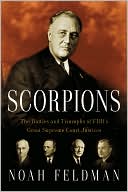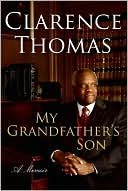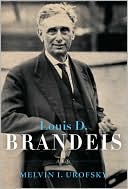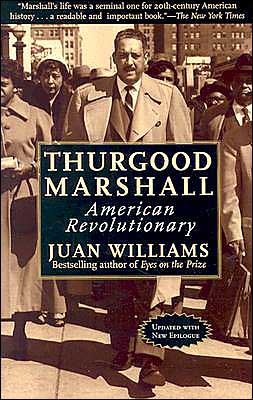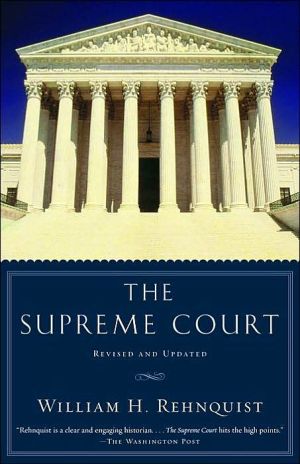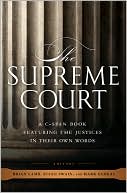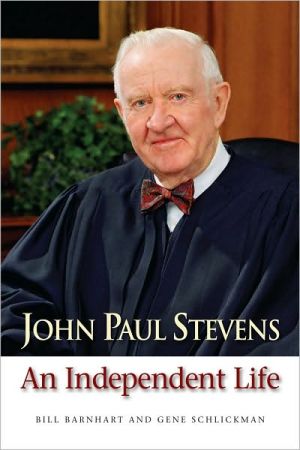Becoming Justice Blackmun: Harry Blackmun's Supreme Court Journey
"A fascinating book. In clear and forceful prose, Becoming Justice Blackmun tells a judicial Horatio Alger story and a tale of a remarkable transformation . . . A page-turner."—The New York Times Book Review\ In this acclaimed biography, Linda Greenhouse of The New York Times draws back the curtain on America's most private branch of government, the Supreme Court. Greenhouse was the first print reporter to have access to the extensive archives of Justice Harry A. Blackmun (1908-99), the man...
Search in google:
NYTB: An inside look at the U.S. Supreme Court in the 1970s, 1980s, and early 1990s, based on the papers of Harry A. Blackmun The New York Times - Jeffrey Rosen Linda Greenhouse, the Supreme Court correspondent for The New York Times, is widely respected not only for her scrupulous translations of complicated opinions and traditions but also for her care in avoiding gossip and preserving the justices' privacy. In her first book, Becoming Justice Blackmun, she has produced something unexpected: one of the most intimate and revealing portraits of the relationship between two justices ever achieved … Ms. Greenhouse's achievement in her meticulous narrative history is to provide new ammunition for Justice Blackmun's critics as well as his admirers. And readers who are unfamiliar with the inner workings of the court could not hope for a more engrossing introduction.
Becoming Justice Blackmun\ Harry Blackmun's Supreme Court Journey \ \ By Greenhouse, Linda \ Times Books\ Copyright © 2005 Greenhouse, Linda\ All right reserved.\ ISBN: 080507791X \ \ \ \ \ \ From Becoming Justice Blackmun:\ Planned Parenthood v. Casey was argued on April 22, 1992. As in the Webster case three years earlier, it was not clear from the discussion at the conference whether Roe v. Wade itself was really on the table. But while there was uncertainty as to the details, Blackmun knew he would be writing a dissent. \ Rehnquist circulated a twenty-seven-page draft majority opinion on May 27. "Wow! Pretty extreme!" Blackmun wrote in the margin of the first page. All the Pennsylvania law's provisions were upheld. Further, Rehnquist said the Court had been "mistaken in Roe when it classified a woman's decision to terminate her pregnancy as a 'fundamental right.' " \ Then, suddenly, everything changed. Two days later, a handwritten note arrived from Anthony Kennedy. "Dear Harry, I need to see you as soon as you have a few free moments. I want to tell you about some developments in Planned Parenthood v. Casey, and at least part of what I say should come as welcome news."\ When the two met the following day, Kennedy revealed that he, O'Connor, and Souter had been meeting privately and were jointly drafting an opinion that, far from overruling Roe, would save it-not in its details, but in its essence. The constitutional right to abortion would be preserved.\ \ \ Continues... \ \ \ \ Excerpted from Becoming Justice Blackmun by Greenhouse, Linda Copyright © 2005 by Greenhouse, Linda. Excerpted by permission.\ All rights reserved. No part of this excerpt may be reproduced or reprinted without permission in writing from the publisher.\ Excerpts are provided by Dial-A-Book Inc. solely for the personal use of visitors to this web site. \ \
\ From Barnes & NobleThough major changes took place in the makeup of the Supreme Court in 2005-6, New York Times writer Linda Greenhouse focuses on Justice Harry Blackmun, a Nixon appointee whose odyssey placed him in a startling role amid some of the most crucial legal controversies of our time. Engrossing and enlightening, Greenhouse's biography earns its place as a classic about this much-discussed bulwark of the U.S. government.\ \ \ \ \ From the PublisherNATIONAL BESTSELLER\ "[A] wonderful book . . . one of the most intimate and revealing portraits of the relationship between two justices ever achieved."—Jeffrey Rosen, The New York Times\ "A graceful account, filled with well-chosen quotations, apt observations and elegant legal summaries." —The Washington Post Book World\ "Reprises in rich, thoughtful, and more extensive detail the main emotional and interpretive threads of Blackmun's career." —David J. Garrow, The New Republic\ "Highly readable and interesting . . . Greenhouse has mined [Blackmun's private papers] brilliantly to create a moving narrative." —Los Angeles Times\ "A riveting account of [Blackmun's] life." —Anna Quindlen, Newsweek\ "[A] fascinating volume . . . Becoming Justice Blackmun is as welcome as it is interesting . . . informative and moving." —The Washington Times\ "Should inform anyone with an interest in the law and how the court operates . . . Blackmun, a precise writer and exacting editor, would approve." —USA Today\ "A model biography of a Supreme Court justice . . . Greenhouse delivers a crystal-clear, and sometimes painful, portrait of the way personality shapes history." —The Courier-Journal (Louisville)\ "Greenhouse sets a high standard in offering an intimate look both at the man and at the development of his judicial thought." —Publishers Weekly, starred review\ \ \ \ Jeffrey RosenLinda Greenhouse, the Supreme Court correspondent for The New York Times, is widely respected not only for her scrupulous translations of complicated opinions and traditions but also for her care in avoiding gossip and preserving the justices' privacy. In her first book, Becoming Justice Blackmun, she has produced something unexpected: one of the most intimate and revealing portraits of the relationship between two justices ever achieved … Ms. Greenhouse's achievement in her meticulous narrative history is to provide new ammunition for Justice Blackmun's critics as well as his admirers. And readers who are unfamiliar with the inner workings of the court could not hope for a more engrossing introduction.\ — The New York Times\ \ \ \ \ Publishers WeeklySupreme Court justice Harry Blackmun's lifelong connection with Chief Justice Warren Burger-beginning in kindergarten in St. Paul, Minn., and culminating in 16 years together on the Supreme Court-supplies Greenhouse with one of her main organizing themes in this illuminating study of Blackmun's life and intellectual history. Once the closest of friends, Blackmun (1908-1999) and Burger diverged personally and ideologically, beginning in 1973, when Burger assigned Blackmun to write the Court's opinion in Roe v. Wade. Greenhouse, the New York Times's veteran Supreme Court watcher, draws primarily on Blackmun's massive personal archive to show how his authorship of the majority opinion in Roe (7-2) propelled him down several unexpected paths. Blackmun embraced equal protection for women and came to reject capital punishment. A Nixon appointee, Blackmun became the Supreme Court's most liberal justice after the retirement of William Brennan and Thurgood Marshall. The personality that emerges in Greenhouse's portrayal is that of a self-effacing and scholarly judge, devoid of partisanship, willing to follow his ideas wherever they led him. Making no pretense at being definitive or comprehensive, Greenhouse sets a high standard in offering an intimate look both at the man and at the development of his judicial thought. B&w photos. (May) Copyright 2005 Reed Business Information.\ \ \ \ \ Library JournalA Pulitzer Prize-winning Supreme Court journalist and commentator for the New York Times, Greenhouse offers an exceptionally readable biography of Justice Harry Blackmun, from his childhood to his service on the Supreme Court. Drawing upon primary-source materials in the Harry A. Blackmun Collection at the Library of Congress, Greenhouse portrays the evolution of Blackmun's judicial philosophy. In using Blackmun's files, correspondence, and papers, the author creates a revealing portrait of both the man himself and the inner workings of the Supreme Court, including his fractious relationship with Chief Justice Warren Burger. Central to the narrative is Blackmun's involvement in Roe v. Wade, subsequent abortion litigation, and capital punishment litigation. This small book is a valuable addition to the existing body of judicial biographies. Highly recommended.-Theodore Pollack, New York Cty. Public Access Law Lib., New York Copyright 2005 Reed Business Information.\ \ \ \ \ Kirkus ReviewsThe life and times of a Supreme Court justice who resisted easy categorization, then and now. On his death in 1999, writes New York Times Supreme Court correspondent Greenhouse, Harry Blackmun gave the Library of Congress his papers, "contained in 1,585 boxes that take up more than six hundred feet." Drawing on this wealth of primary information, Greenhouse turns in a nuanced study of Blackmun as legal thinker and judge. Along the way, she offers revealing notes on Warren Burger, whose own papers are sealed until 2026; Burger, Blackmun's childhood friend and fellow Minnesotan, helped see Blackmun onto the bench. Other Minnesotans were guarded in their support: Walter Mondale dismissed him as a conservative, and Hubert Humphrey was not enthusiastic. Blackmun gave liberal critics reason for concern, as when he dissented from the opinion allowing the New York Times to publish the Pentagon Papers, remarking, "The First Amendment, after all, is only one part of an entire Constitution." (A citizen from New Jersey wrote in to say, "I thought you were a ‘strict constructionist'. . . . More a strict Nixonist.") Yet Blackmun also took it on himself to write the Court's opinion on Roe v. Wade, interpreting it not simply from the woman's-choice stance but also as "primarily, a medical decision." Blackmun had to defend Roe v. Wade for the rest of his career, as a target of those who wished to outlaw abortion entirely; he was relieved when in 1992 five justices declared that "the essential holding of Roe v. Wade should be retained and once again reaffirmed." Greenhouse observes that their time spent together on the bench did ill for Blackmun's friendship with Burger, whom he came to regard as a pooradministrator and shallow thinker; the animosity grew in the matter of United States v. Nixon, which bitterly divided the Court. So, too, would other issues-among them, toward the end of his career, the death penalty-and by Greenhouse's account Blackmun conducted himself well throughout them. Detailed and well considered: a welcome study of Blackmun's contributions to the law. Author tour\ \

